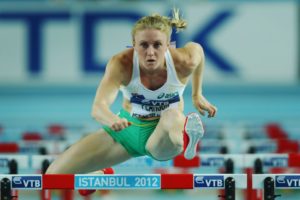April 18, 2017
One thing I’ve always had a fascination with when it comes to the hurdles is comparing the styles of the top hurdlers and noticing their similarities and differences, their strengths and weaknesses. In a blog post three years ago I compared the hurdling style of David Oliver to that of Roger Kingdom (https://hurdlesfirstbeta.com/2014/04/20/d-o-kingdom-comparison/). Though a generation apart, their styles, and their body types, were so similar that it was almost eerie. Turns out that Oliver said Kingdom had been his favorite hurdler growing up, and that he had studied his style closely in his fledgling hurdling years.
In Keni Harrison’s last two years of high school, when she first took up the hurdles as her athletic focus, I was her private hurdles coach. When it came to discussing professional hurdlers to model her style after, I brought up only one name: Sally Pearson. “If you really want to learn how to hurdle,” I told Keni, “watch Sally.” As Keni has moved on and moved up the ranks – first as a collegian, then as a professional, and now as the current world record holder – she has refined her style to the point where it can be said that she is the equal of Pearson when it comes to technical efficiency.
In the photos above – of Harrison from her world record year of 2016 and of Pearson from her Olympic gold medal year of 2012 – the similarities between the two hurdlers’ styles are quite evident. I tried to find two photos in which they were at the same point in hurdle clearance, so these two pics work pretty well. Here are my observations:
Both Harrison and Pearson have what many hurdle coaches refer to as a “bent” lead leg, meaning that the knee stays slightly bent when the foot extends to attack the barrier. This style is effective because it allows the lead leg to cycle fluidly with no pauses in the hurdling action, and it enables the athlete to maintain more control over the leg. Therefore, the athlete is able to avoid lateral movement in the lane, and is able to keep moving in a straight line through the hurdle and between the hurdles. With hurdlers who have a straight-leg lead, the hips tend to tilt to the lead leg side, creating a slight imbalance, compromising forward momentum.
The lead arm of both Harrison and Pearson has almost completed its full motion before the heel of the lead leg has crossed the bar. This means that the lead arm is leading the action – it isn’t waiting on the lead leg; it is forcing the lead leg to keep up, thereby also speeding up the trail leg.
With both of them, the toes of the foot of the lead leg are pointing up, indicating that the ankle is dorsi-flexed, which again allows for more control and a forceful, fluid hurdling action.
Both of them are leaning forward deeply from the waist, bringing the chin down, keeping the eyes focused forward, keeping the hips pushing forward, allowing for low hurdle clearance, minimal air space, and minimal air time.
The trail leg of both hurdlers is in position to drive forcefully and swiftly to the front. One of the key elements of Liu Xiang’s style that really caught my eye was that his trail leg did not lag. It was high at this point of hurdle clearance, and the knee was facing forward. With a lot of hurdlers, the trail leg knee is pointing down, or is pointing sideways, flattening out too much, with the groin opening too widely. In the case of Harrison and Pearson, the trail leg isn’t as high as Xiang’s would be, but it doesn’t need to be because the women’s hurdles are so low that just maintaining the positioning of a normal sprinting stride will do. As the photos show, the trail leg knee of both Harrison and Pearson is facing the front, allowing for a minimal opening of the groin, which makes for a super-fast trail leg that almost looks like a lead leg. That’s some beautiful hurdling bruh.
Hopefully, with Harrison coming off a world-record year and Pearson coming back strong from injury, we’ll be able to see the two of them competing against each other at their best this summer.


